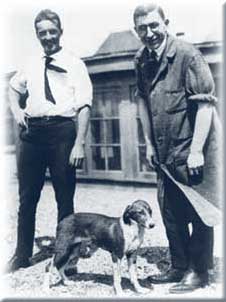Charles Best and Frederick Banting

Recombinant DNA technology launched a new era in biology. The idea that DNA still "functions" when transferred from one organism to another opened up worlds of possibilities. Even as the technology was being perfected, scientists were already thinking of practical applications. One of the first was to use recombinant DNA technology to make insulin. Before the discovery and isolation of insulin in 1922, a diagnosis of diabetes was a death sentence. Diabetics lack a protein called insulin, produced by the pancreas, which helps the body regulate sugars. Without insulin, the body cannot use sugars properly for energy. There was, and still is, no cure for diabetes.
Charles Best (L) and Frederick Banting (R) discovered insulin, 1928.
Recombinant DNA technology launched a new era in biology. The idea that DNA still "functions" when transferred from one organism to another opened up worlds of possibilities. Even as the technology was being perfected, scientists were already thinking of practical applications. One of the first was to use recombinant DNA technology to make insulin.
Before the discovery and isolation of insulin in 1922, a diagnosis of diabetes was a death sentence. Diabetics lack a protein called insulin, produced by the pancreas, which helps the body regulate sugars. Without insulin, the body cannot use sugars properly for energy. There was, and still is, no cure for diabetes.
recombinant dna technology,frederick banting,diagnosis of diabetes,worlds of possibilities,cure for diabetes,death sentence,practical applications,insulin,pancreas,diabetics,new era,organism,isolation,diabetes,biology,protein,scientists,discovery
- ID: 15641
- Source: DNALC.DNAi
Related Content
15928. How insulin is made using bacteria
Synthetic human insulin was the first golden molecule of the biotech industry and the direct result of recombinant DNA technology. Currently, millions of diabetics worldwide use synthetic insulin to regulate their blood sugar levels. Synthetic insulin i
15929. How insulin is made using yeast
Synthetic human insulin was the first golden molecule of the biotech industry and the direct result of recombinant DNA technology. Currently, millions of diabetics worldwide use synthetic insulin to regulate their blood sugar levels.
15067. Promises of gene therapy, Mario Capecchi
Mario Capecchi talks about the possible use of embryonic stem cells and gene targeting techniques to develop new therapies for for diabetes and Parkinson's.
15255. Producing human insulin using recombinant DNA, Walter Gilbert
Walter Gilbert talks about the reasons for making insulin with recombinant DNA.
16884. Genome Scans Pay Off
Scans of the entire human genome turn up genes involved in common diseases.
800. Imaging Alzheimer's Disease
Neuroimaging techniques help scientists visualize Alzheimer's disease before the disease becomes debilitating.
15052. Effects of DNA variation on health, Stephen Fodor
Stephen Fodor talks about the need to look broadly across the genome to find the relationship between genes and health in different people.
855. Brain Banks and Ethics
Donated brains become are indispensable to enabling scientists to spot and characterize what is abnormal in afflicted brains.
16705. Animation 34: Genes can be moved between species.
Stanley Cohen and Herbert Boyer transform bacteria with a recombinant plasmid, and Doug Hanahan studies induced transformation.
1361. Model Organisms (Lesson)
Students work through a series of experiments that investigate the use of model organisms in the search for a better understanding of the genes that influence memory formation.












